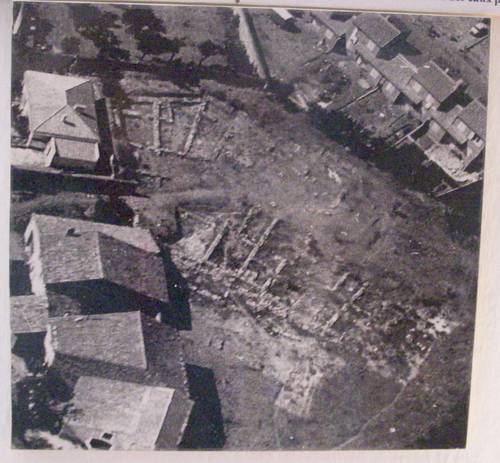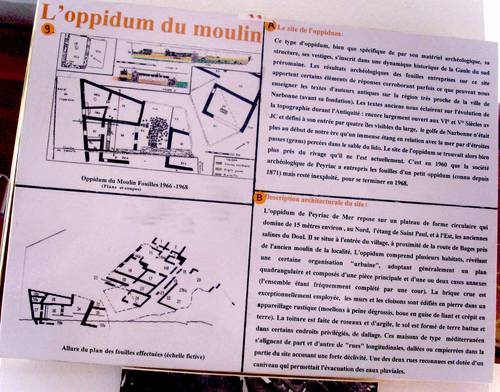PEYRIAC SUR MER
This village situated on the étang de Bages et de Sigean was well-known during Roman days - and before.
Peyriac, the village as seen from the salt-pans.
Between Peyriac and the island of Doul opposite, are the salt-pans, worked by the Romans for the precious salt, as shown by this engraved stone in the museum. (It's a facsimile - the original is in the archeological museum at Narbonne.)
With its explanation;
The history of the village goes back to 500BC. The local Celtic tribe, the Elysiques, who lived at various places along this coastline, Sigean and Nissan especially, had a village at Peyriac beside today's étang de St. Paul. The remains were discovered when the commune started building houses in this part of Peyriac.
The Elysiques traded with the Greeks and the Romans, there's an Attic vase in the museum dated 400BC.
Isn't it beautiful? The museum explained more . . .
Celtic pottery is also well represented, made in a style so elegant and with such a modern concept, it could have been made by a fashionable master potter.
I was very impressed.
Several tombs were also found on this site which was abandoned at the beginning of the second century BC, it's thought because of a fire. The Romans arrived in our region in 118BC, that's the date of the foundation of Narbonne. There are many typically Roman remains in the museum, amphores, mosaic floors, glass, sigillée and poterie noir.
Many Roman remains have been found at Peyriac, particularly at Carrières, on the north side of the island of Doul. Someone who wanted to make a well in 1915 found a terra cotta jar full of silver coins dating from the first century BC to the first century AD. The archeologists arrived and the excavations revealed a building with a large cellar. It's thought it was storage for the private house or for a small trader. One wanders why he left his money behind; maybe he died while away from home and hadn't told his family where he had hidden it.
Also on the island, a financial treasure found in 1957 persuaded the archeologists to do excavations. The finds included articles in bronze and others which proved much trading around the Mediterranean; a head of Apollo, a coin of Héraclès, a scarab of Egyptian origin.
Meanwhile, at the place called Saint Paul, a little to the north towards Bages, there's a cross which marks the exact spot where St.Paul Serge of Narbonne arrived in France to evangelise the region.


The stones give the impression there was a building here. On the back of the cross is the date 1815.
In 1911 a Constantine coin was found (4th century) and in 1930 "une tombe à dalle", that is, made from the big Roman rooftiles called tegulae. Tombs made like this were generally Visigothic. Eventually, in 1955, excavations were done in the field behind the cross, and they found a Visigothic Graveyard with a small church dedicated to St.Paul Serge. You can find the history of St.Paul Serge in the Bible, Acts 13, 4-12. Paul Serge was converted around 48 AD; one thinks he arrived in the Narbonnais around 50AD.
This cross is beside the "Sentier du Golf Antique", which has recently been covered in concrete for the benefit of walkers and cyclists. It is no longer possible to drive from Peyriac to Bages as it used to be. The Eetang was larger in olden days, and looking at the map (IGN 2456OT) I am quite certain this road was of Roman origin, perhaps a Celtic beaten track that they paved.


Photos I took back in 2011 before the road was covered.
Practical Info
The museum is open Wednesdays and Sundays in July and August from 16h to 18h, for the rest of the year only on Sundays.
The archeological discoveries at Peyriac are listed in the Carte Archeologique de Gaule, tome 11/1, Narbonne et le Narbonnais. Cliquez ici.
Inscrivez-vous au blog
Soyez prévenu par email des prochaines mises à jour
Rejoignez les 16 autres membres
















